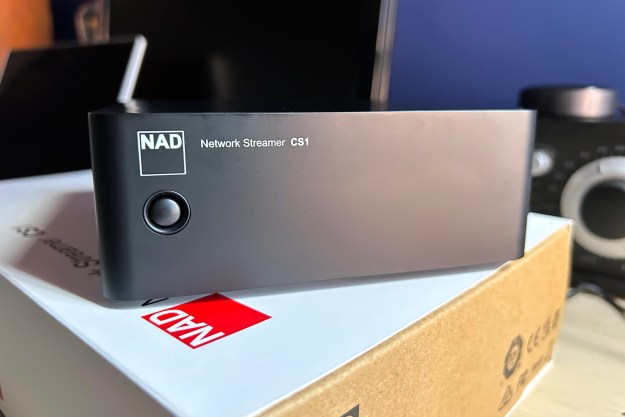
- Excellent build quality
- Simple setup
- AirPlay 2, Chromecast, Bluetooth
- Tidal Connect with MQA
- No dedicated app
- Uneven streaming service support
- No hi-res Bluetooth codecs
I admit it, I have a soft spot for NAD products. As a teen growing up in the 1980s, I spent more than a few hours drooling over the company’s minimalist black receivers, turntables, and cassette decks at friends’ houses and the occasional hi-fi store. I still adore the understated, all-business design that dares anyone to disagree with the statement “form follows function.”
And while that same understated design philosophy can be clearly seen in the company’s latest product, the $349 CS1 Endpoint Network Streamer, I’m a little let down by NAD’s choices for this particular minimalist black box.
Why do I need a network streamer?
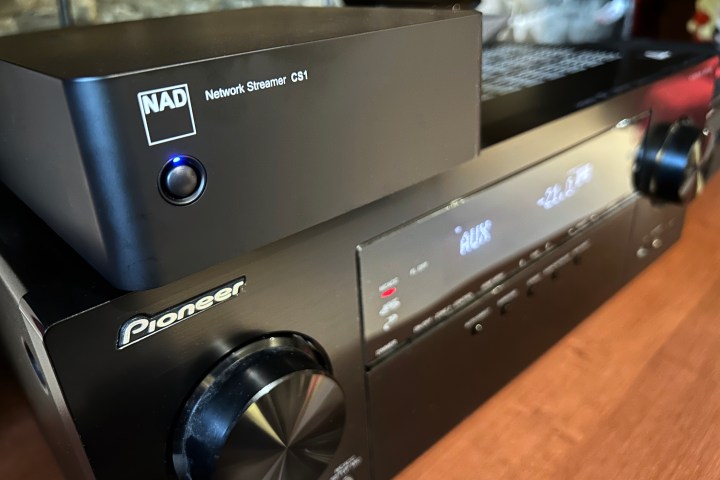
Before I dive into the details, a quick primer for folks who haven’t a clue what a network streamer is or why you would want one. If you have a sound system you love, but it comes from the pre-music streaming era, attaching a network streamer is a plug-and-play way to drag it into the 21st century. These devices connect to your network wirelessly or via Ethernet, and they’re typically compatible with a huge range of streaming services and any digital music you might have saved on your computer or a network-attached storage device (NAS).
Network streamers aren’t new. In fact, one of Sonos’ very first wireless audio products was a network streamer, and that arrived in 2006. They took a back seat to all-in-one wireless speakers for a while, but lately we’ve seen a resurgence of dedicated streamers, probably because of the growing popularity of lossless CD quality and hi-res audio that’s now available from services like Apple Music.
Just keep in mind that some network streamers have built-in amplifiers that let you connect almost any set of passive, wired stereo speakers — or you can run their signals into your stereo system. But the CS1 belongs to the non-amplified category of network streamer, so you’ll need a set of powered speakers or you won’t be able to hear a thing. Any amplified system will do — from a standalone set of powered stereo speakers like Klipsch’s The Sevens to a top-of-the-line 11.1-channel AV receiver-based home theater system, or anything in-between. As long as it has an analog and/or digital input, you’re good to go.
Not all streamers are created equal
One more thing you definitely need to know: It’s easy to focus on the words “network streamer” in the CS1’s full product name (CS1 Endpoint Network Streamer), and skip right over the word “Endpoint.” But that word is more important than you might think.
Unlike nearly every other kind of network streamer on the market (we’ll discuss a few competitors in a moment), there is no companion app or physical remote control for the CS1. As an endpoint device, it’s designed to work with a variety of third-party apps and services, and will faithfully follow the commands issued by those apps. But without those apps, there is no way to control what it does. Even a $30 Bluetooth speaker has physical play/pause buttons and volume controls. The CS1 has no controls of any kind. For some, this could be a deal-breaker, so I’ll spend most of this review helping you figure out if an endpoint (and specifically, the CS1) is right for you.
Simple, solid design

Physically, the CS1 is pure NAD: solidly built and surprisingly weighty for a device that has no amplifier. If you take a close look, you can see why. NAD has used a metal chassis under the plastic skin, and I have no doubt that the internal components are equally robust, even though I can’t see them. A single button with a tiny integrated LED is the only visible physical control (though not the only button, which I’ll get to in a moment). You use it to wake the CS1 if it’s in standby mode or send it into standby mode. I have no idea why this button even exists. Most network streamers take care of their standby modes automatically.
In terms of size, it has the same footprint as two of its biggest rivals, the $449 Sonos Port and $149 Wiim Pro, but the CS1 stands a little taller. I think it looks great, but if you want to tuck it away, go for it. As I mentioned above, there’s no remote control and no infrared receiver, so it doesn’t need to be visible for line-of-sight control.
On the back you’ll find everything you need to connect the CS1 to your system, including two digital outputs (optical and coaxial) and one set of analog stereo RCA outputs. Right away, that gives the CS1 a bit of an edge over the Sonos Port, which lacks an optical output. In keeping with its core role as an endpoint, there are no inputs on the CS1. You can’t use it as a way to pipe an external source like a turntable into your system, something both the Port and the Wiim Pro can do.
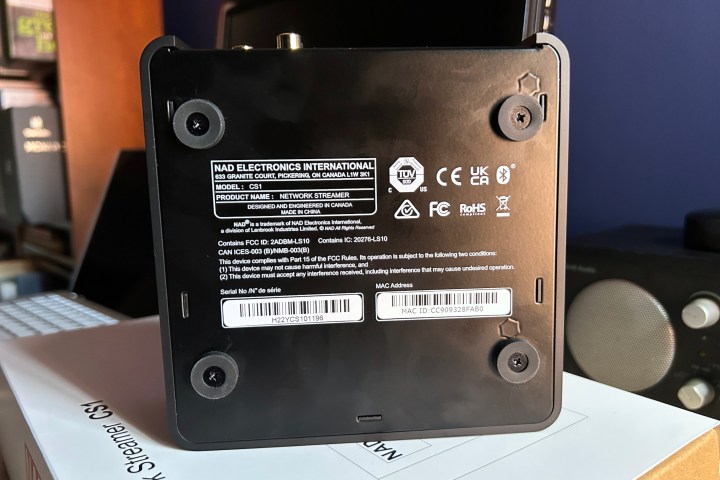
With dual-band 2.4/5GHz Wi-Fi, a wireless connection probably is the way most folks will use the CS1. But you also get an Ethernet port for those who want a wired connection to their home network. A 12-volt trigger output can be used to power up and shut down connected devices like an amplifier or receiver when the CS1 wakes from or returns to standby mode, but these days, it’s unusual to find a matching input on anything but high-end gear. My midrange Pioneer AVR, for example, doesn’t have one.
You also will notice a tiny hole labeled “Setup.” Believe it or not, if you want to connect a Bluetooth device to the CS1, you’ll need to grab something thin and pointy and use it to press the button that’s hidden in the hole. NAD doesn’t include any thin and pointy things in the box.
In fact, NAD doesn’t include much in the CS1 box at all. You get a stereo RCA patch cord and a USB-A-to-USB-C power cord, but that’s it. No digital cables at all. I’ll give NAD a little credit for shipping the CS1 with a generous set of international power plug adapters, but that seems more like a convenience for NAD (one product for all markets) than a service to its customers.
You also don’t get a full instruction manual. As is becoming the norm, NAD encourages you to download it from the NAD website, in the CS1’s “Software and Downloads” section.
Easy to set up
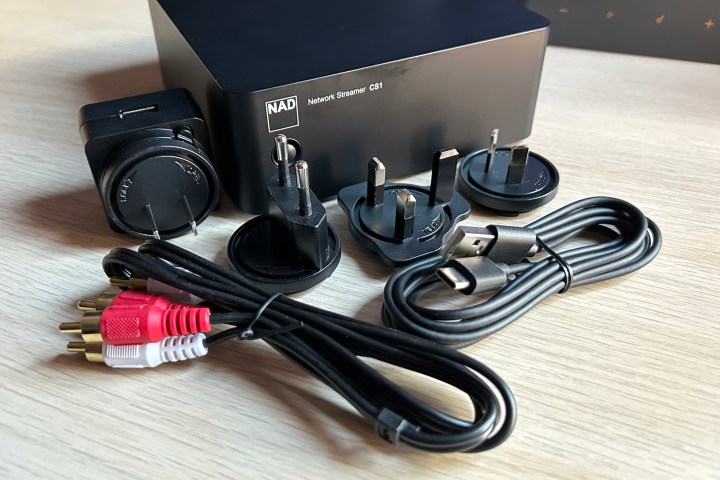
Still, those instructions won’t be needed for long once you get them — getting the CS1 set up is very easy. There are a few different options depending on whether you’re going wired or wireless. If wired, just plug the CS1 into an Ethernet cable and you’re done. If wireless, it depends on whether you’re an iPhone or Android user. After you plug the CS1 into the wall, you’ll see the small LED flash blue rapidly, then switch to an alternating red/blue pattern. At that point, iPhone users can go to their Wi-Fi settings menu, where they’ll find the option to set the CS1 up as an AirPlay 2 speaker. Android users can do the same, but it happens inside the Google Home app, which lets you use the CS1 as a Chromecast audio device. And that’s it.
Pro tip: If you’re an iOS user and you want to use the CS1 as a Chromecast audio device in addition to AirPlay 2, you can simply use the Google Home app and save yourself a step.
On the one hand, this app-free approach is kind of refreshing. No app means no messing around with settings or complicated menus, and no real data-logging concerns. You don’t even have to worry about performing firmware updates because the CS1 manages these automatically as soon as you’ve connected it to your network.
You’ll need a (third-party) app for that
The downside to this arrangement, as I alluded to above, is that without any app of its own you’ll need to use a dedicated app for each and every music source you want to play.
For Spotify and Tidal users, it means you can control the CS1 from within these apps. If your needs are simple, this works well: if you’ve ever used a Bluetooth speaker, there’s zero learning curve in order to use the CS1 — it’s the exact same procedure. Connect, hit play, and enjoy your music. In fact, if you’re a Tidal HiFi Plus subscriber, you’ll get the best possible audio quality by using Tidal Connect to stream to the CS1 from within the Tidal app on iOS or Android. Doing so lets you stream Tidal’s Master tracks in Master Quality Authenticated (MQA) format directly to the CS1, which is capable of performing the final level of MQA rendering needed to hear MQA at its full quality.
Uneven service support
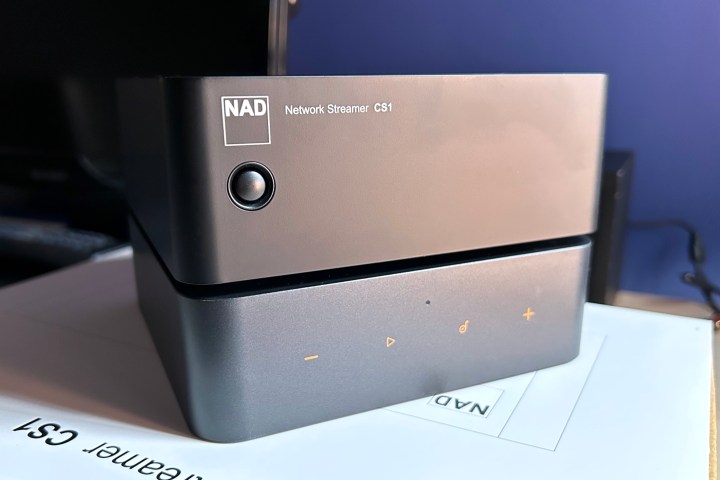
However, for other music services, or for listening to your home collection of digital music, you’ll be relying on yet more apps to complete your listening experience. For instance: There’s no way to tell the CS1 that you want to listen to your personal library of rare jazz recordings, so you’ll have to download an app that can do it. Is your collection in iTunes or Apple Music? Apple’s apps will probably work fine, but you’ll be limited to AirPlay’s CD-quality streaming.
Want hi-res lossless audio support? Now things start to get tricky. Officially, the CS1 can handle hi-res lossless all the way up to 24-bit/192kHz. However, it can’t stream directly from any of the services that offer hi-res lossless, like Apple Music, Amazon Music, and Qobuz, which means you’ll be playing these tracks on your phone and streaming them to the CS1 yourself.
That’s especially bad news for Apple Music subscribers who have iPhones (which I’m guessing is the majority of Apple Music subscribers). The only way to stream Apple Music from an iPhone to the CS1 is via Bluetooth (bad idea — I’ll explain why shortly) or AirPlay 2. And I repeat: AirPlay 2 only supports 16-bit lossless audio, not 24-bit hi-res lossless.
Amazon Music customers may fare better. This service supports AirPlay 2 on iOS, and also Chromecast on both iOS and Android. Unlike AirPlay 2, Chromecast can handle up to 24-bit/96kHz. Unfortunately, due to a bug that has yet to be fixed, Amazon Music refused to stream anything higher than 16-bit lossless over Chromecast to the CS1 — the first time I have run into such a limitation.
But even if Chromecast had been working as it should, it would still leave the very highest level of lossless audio on these services (24-bit/192kHz) out of reach.
Your last hope for getting the CS1 to deliver its very best performance is to download an app like the excellent Bubble UPnP for Android. Bubble lets you browse your private library of digital music as long as it’s accessible on a DLNA or UPnP server, and then stream those tracks at full quality to the CS1. At least, NAD says you should be able to. Unfortunately, Bubble did not recognize the CS1 as a DLNA-compatible device, so it defaulted back to Chromecast. Foiled again.
MP3, AAC, WAV, FLAC, and ALAC — they’re all supported. Pretty much every format you could want, except DSD, which I have to say, is really disappointing given NAD’s audiophile fan base. You may still be able to play them — an app like Bubble can perform on-the-fly DSD transcoding to PCM, but this feels wrong.
The final nail in the quality coffin is a cruel one: Despite its support for MQA via Tidal Connect, the CS1 is not a full MQA decoder — it needs an app like Tidal to help it out — so you won’t be able to play any MQA files you might have in your personal library at their better-than-CD-quality resolution.
If your eyes are beginning glaze over and you’re wondering why not just use the CS1’s Bluetooth connection and dispense with all of the Wi-Fi streaming headaches, that’s absolutely an option. But since the CS1 only supports the two worst Bluetooth codecs — SBC and AAC — you’d be better off buying a decent .
Then we get into the question of advanced features like multiroom audio. The CS1 can be used as part of a multiroom system, but only through third-party software: Apple Home if you’re exclusively running AirPlay 2 speakers and Google Home if all of your gear is Chromecast-compatible. You’re out of luck if Amazon’s Alexa runs your smart home — the CS1 isn’t compatible with that ecosystem.
This makes my job really hard. You’d probably like to know what it’s like to use the CS1, but the truth is, it totally depends on what you’re trying to do with it, and the platform/app/streaming protocol you’ve chosen to use.
End of the line for endpoints

These are the fundamental realities of working with an endpoint network streamer as opposed to the kinds of network streamers built by Sonos, Denon Heos, Bose, Wiim, and even NAD’s sister company, Bluesound. Each of these wireless audio companies has a dedicated app, giving you lots of options you simply don’t get on the CS1, such as:
- streaming directly from music services at their maximum audio quality
- combining access to multiple audio sources in a single interface
- universal search
- creating favorites and playlists across music sources
- adjusting EQ or tone control
- multiroom management.
Better yet, if you decide you don’t value their app-based controls and features, you can still use them as endpoint streamers. Sonos and Bluesound support AirPlay 2, while Denon Heos, Bose, and Wiim support both AirPlay 2 and Chromecast audio.
These platforms also have another key benefit: universal control.
With strict endpoint streamers, like the CS1, if you begin playing music from your Apple Music app over AirPlay 2, that music will stop the moment you leave the house, because it’s being controlled by your phone, not the CS1.
Similarly, if someone else in your home wanted to pause that music, they would need the Apple Home app on their own phone — and the CS1 would have to already be set up in the app.
And if your spouse is on Android, and not an iOS device? They have no control at all because even if the CS1 has been added to Google Home, that app thinks of the CS1 as a Chromecast device and it won’t understand that the CS1 is in the middle of playing an AirPlay 2 session.
There is a way to extract a similarly powerful feature set from the CS1, but it comes at a price: use Roon. Roon is an amazing digital music platform with a wide feature set that caters to audiophiles in particular. The CS1, as a certified Roon endpoint, lets you use Roon to manage all of your digital music and then stream it all to the CS1. The catch? Roon costs $15 per month or $830 for a lifetime.
As I said in the intro, it can be tough to get a sense of a network streamer’s sound quality, because it ultimately depends on the gear to which it’s connected. What I can say is that the CS1, when connected to my Pioneer receiver, sounded about the same to me as the Sonos Port and the Wiim Pro when playing sources that were compatible with all three devices. This was true whether I used the streamers’ digital or analog outputs, so if the CS1’s DAC is of arguably higher quality than the ones in either of the other streamers, I guess my sound system (or my ears) weren’t up to the task of being able to tell the difference. All of that to say, the CS1 has everything it needs to deliver great audio quality.
NAD’s Endpoint Network Streamer CS1 is well-built and supports three of the most popular major audio streaming technologies: Bluetooth, AirPlay 2, and Chromecast, and under some circumstances, it lets you play up to 24-bit/192kHz hi-res lossless audio. But its dependence on third-party services and its lack of a companion app severely limit your ability to work with it on your own terms, making it hard to recommend when other products on the market can do more and sometimes cost less.
Editors' Recommendations
- What is Tidal? The hi-fi streaming music service fully explained
- Tidal has rolled all of its premium features into its $11 per month plan
- How much is Apple Music, and how can you get it for free?
- The Canadian company that owns NAD and Bluesound now owns MQA
- Wiim Pro Plus streamer targets audiophiles with upgraded DAC




